Modern Railway Travel Exhibition
Battersea Wharf Goods Yard, 28-30th June 1957

The British Transport Commission organised this exhibition to show off progress under it's Modernisation Plan. On display were locos, coaches and equipment from BR and private builders.
There were three relevant (for this website) exhibtions:
19/20: Swindon vehicles W79083 + W79471
21/22: Wickham vehicle E50415 and the frame of an unknown trailer
32: the ER Diesel Motive Power Instruction Train vehicles DM395225/6[1]
A special brochure was produced, the cover for which is shown on the left. It obviously had to be produced in advance, the pictures it used were commonly used Works pictures. While exhibit 19 was described as being a buffet car, reports indicate that the vehicle exhibited was Trailer First W79471[1]. If you have any further info on this, or any further pictures taken at the exhibition, I would be pleased to hear from you.
British Pathe produced a colour newsclip on the exhibition (which can be seen on YouTube or on their website) but sadly does not feature the DMU vehicles, but the Wickham vehicles can be glimpsed in a B&W clip - on YouTube or on their website.
The following three extracts are taken direct from the brochure.
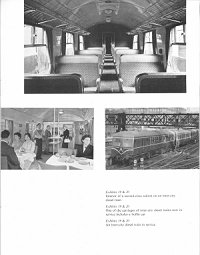
Exhibits 19 & 20
Inter-city Diesel Trains
Designed and built by British Railways
Interior design for buffet compartment: Peter Miller, ARIBA
Inter-city diesel trains have been in service between Edinburgh and Glasgow since January 1957. They are soon to run between Birmingham and Swansea. The trains are normally made up of six vehicles, with a total of 60 first-class seats and from 208 to 232 second-class seats according to the composition of the train. Two vehicles are powered and two are trailers. Two vehicles, which are not in new condition as they have been in service, are exhibited. One contains a buffet compartment. The power cars are equipped with two A.E.C. 6-cylinder 150h.p. diesel engines and with mechanical transmission. All power equipment was supplied by British United Traction Ltd.
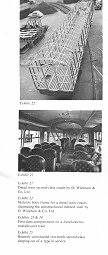
Exhibits 21 and 22
Multiple-unit Diesel-mechanical Coach and skeleton body frame
Designed and built by D. Wickham & Co. Ltd.
Unusual construction methods are a feature of this diesel coach (Exhibit 21). The normal method of mounting the coach on a robust underframe has been dispensed with. Instead, the body frame (Exhibit 22) is constructed of solid drawn square steel tubing approximately 1/8 in. thick, electrically welded into one unit which is capable of withstanding the load and other stresses which may be placed upon it. The completed skeleton body and floor weighs only 5 1/4 tons.
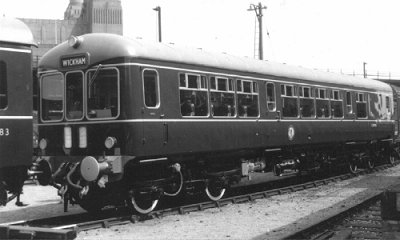
Further weight-saving has been achieved by using 16-gauge aluminium for panelling both the inside and outside of the coach. The floor is of corrugated steel.
The power car is equipped with two Leyland 150 b.h.p. diesel engines, with mechanical drive through four-speed gear boxes. When operated with a trailer there is accommodation for 16 first-class and 109 second-class passengers.
The image shows the Wickham power car E50415, to the left is Swindon power car W79083.
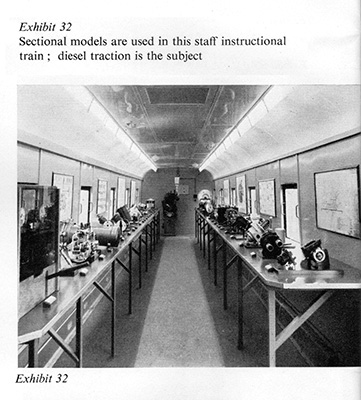
Exhibit 32
Diesel Motive Power Instruction Train
The use of diesel traction on a big scale on British Railways has meant an intensive drive to train staff in the use and maintenance of diesel powered locomotives and other units. As part of this drive, three mobile instructional trains are being provided, the first of which is exhibited. Two vehicles form the train. One coach is a lecture theatre with seating for 32. It is equipped with a sound film projector, an Epivisor, a magnetic board and blackboard and easel. Writing tables are fitted on the backs of all seats.
The second car contains 22 sectional models of diesel equipment and ten test instruments which will be used for demonstration purposes.
A full-time instructor will be in charge of each train and will travel to motive power depots throughout the country. Since night accomodation will not be available at some places, the second car also contains living and sleeping quarters for him.
Layout
Below is the plan from the brochure. Exhibit 1 starts at the bottom row left, with 25 stuck on the back of 11 on the right. The middle row runs from 12 (left) to 24 (right), the top row consists of 32 (left, two-vehicles), then 15 to 18 (right). The small rooms in the building contains 26 (left) to 28 (right).
Exhibit 1: 3,300hp diesel-electric loco (Deltic)
Exhibit 2: 1,000hp diesel-electric loco (Class 20)
Exhibit 3: Diesel-electric shunting locomotive (350hp type)
Exhibits 4 to 18: Prototype Passenger Vehicles built by BR Doncaster, Cravens, BRCW, GRCW & Met-Camm.
Exhibits 19 & 20: Inter-city Diesel Trains
Exhibit 21 & 22: Multiple-unit Diesel-mechanical Coach and skeleton body frame
Exhibit 23 & 24: Diesel-electric Multiple-unit Coaches (Hastings)
Exhibit 25: Sleeping Car
Exhibit 26: Station Waiting Room
Exhibit 27: Ticket Office
Exhibit 28: Lounge Buffet
Exhibit 29: 'Self-Help' Passenger Barrow
Exhibit 30: Platform Refreshment Trolley
Exhibit 31: Train Corridor Trolley
Exhibit 32: Diesel Motive Power Instruction Train
Exhibit 33: Office Furniture
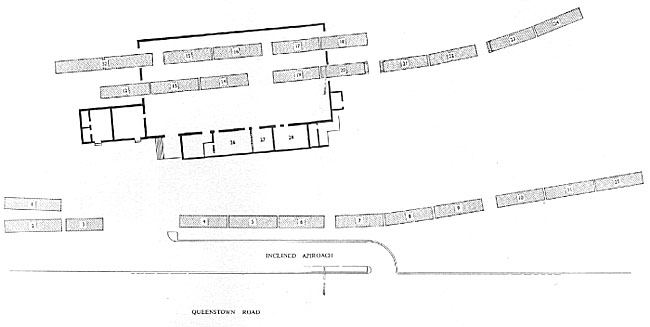
References
- ⋏ a b p179 July 1957 Railway Observer (Railway Correspondence and Travel Society)
Putting the part completed vehicle on display was not an isolated incident, a part finished Class 108 vehicle was known to travel to the Continent to take place in an exhibition.


